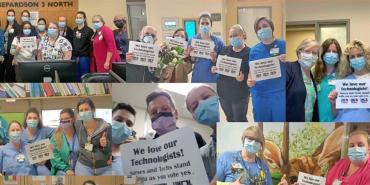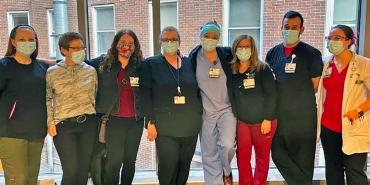Sometimes, there is a misconception when it comes to organizing a union, says Lori Draper. People think that you’re trying to change things, but it’s the opposite,” says Draper, a CT/NM imaging technologist at the University of Vermont Medical Center in Burlington.
Stacey Streeter, a CT scan technologist also at the UVM Medical Center, says the realization that she didn’t want anything about her job to change guided her decision to vote to unionize. “I love my job, and I wanted to know that what I have is not going to be taken away from me because management decides to do it,” she says. For Streeter, having a union means you can “protect what’s good and improve what’s bad.”
Draper and Streeter were among the 230 technologists at the UVM Medical Center who said yes to form a union this past April. The health professionals, including sonographers, cardiac technicians, interventional technologists and radiologic technologists, voted 123-32 to affiliate with the Vermont Federation of Nurses and Health Professionals, joining the more than 2,400 nurses and technicians who are also VFNHP members at the hospital.
The technologists began their quest for representation last year after a cybersecurity attack at the hospital and in response to the COVID-19 pandemic. The cyberattack lasted for nearly a month, and departments were affected differently, but everyone felt the impact. The pandemic was “the straw that broke the camel’s back,” says Streeter.
“That’s when we realized the other unionized members of the hospital had protections that we did not,” says Draper.
After talking with one another, the technologists realized that although they were in different departments, many of their challenges and frustrations were the same. Even though the group had tried to organize before, this time was different.
“It happened very organically,” says Mike Popovitch, an inpatient X-ray technologist. “It was eye-opening for all of us to see what each department was going through. Over the years, conditions didn’t improve, and the fixes were simply Band-Aids,” said Popovitch. “That’s when I said we need to do something about it.”
“Healthcare has been changing for years with a decreased emphasis on the voices of the professionals who make patient care possible,” says Mike Bernier, an MRI technologist. “Our voice will enhance our work through fair pay and compensation practices, job security, protections, transparency and direct involvement of the technologists. Our union will increase our ability to attract and retain high-quality, knowledgeable professionals. Our patient care can only benefit from the added weight of our collective involvement in the decision-making process.”
As the technologists prepare to enter into contract negotiations with the UVM Medical Center’s administration, they hope to address wages, recruitment and retention, and policies that affect work-life balance in their first contract.
[Adrienne Coles]


